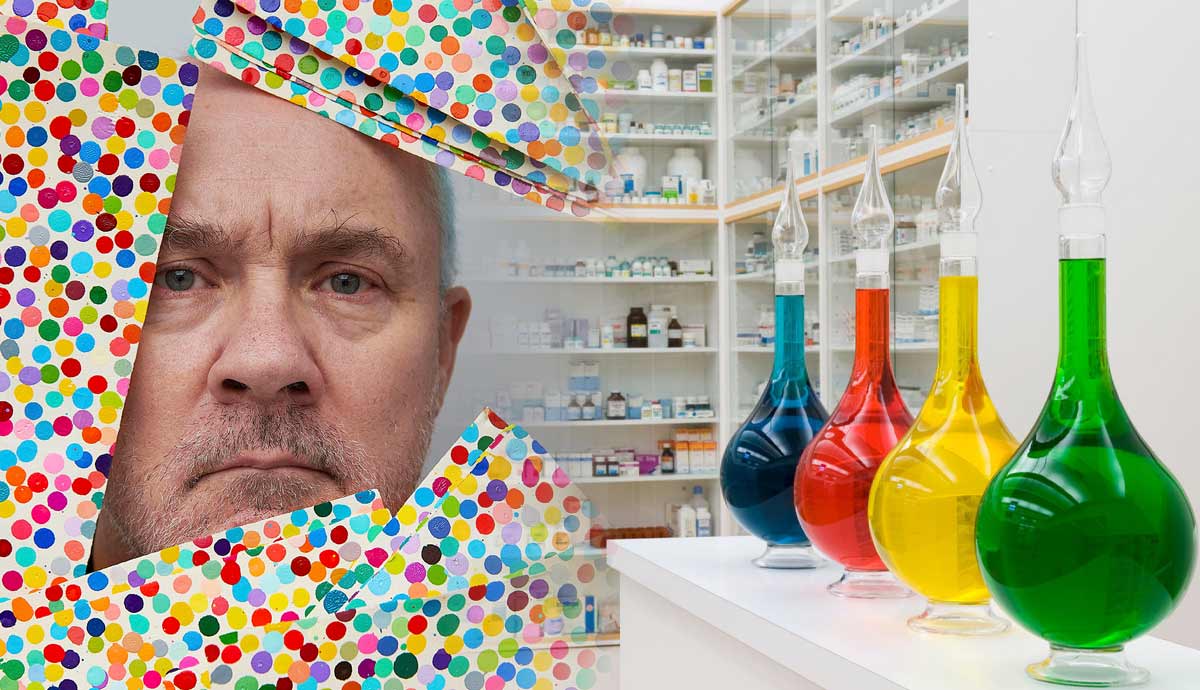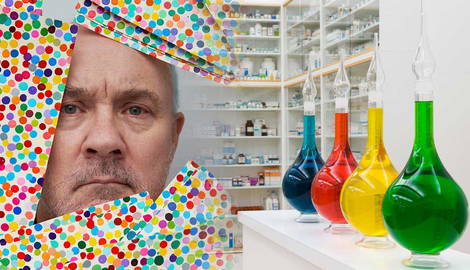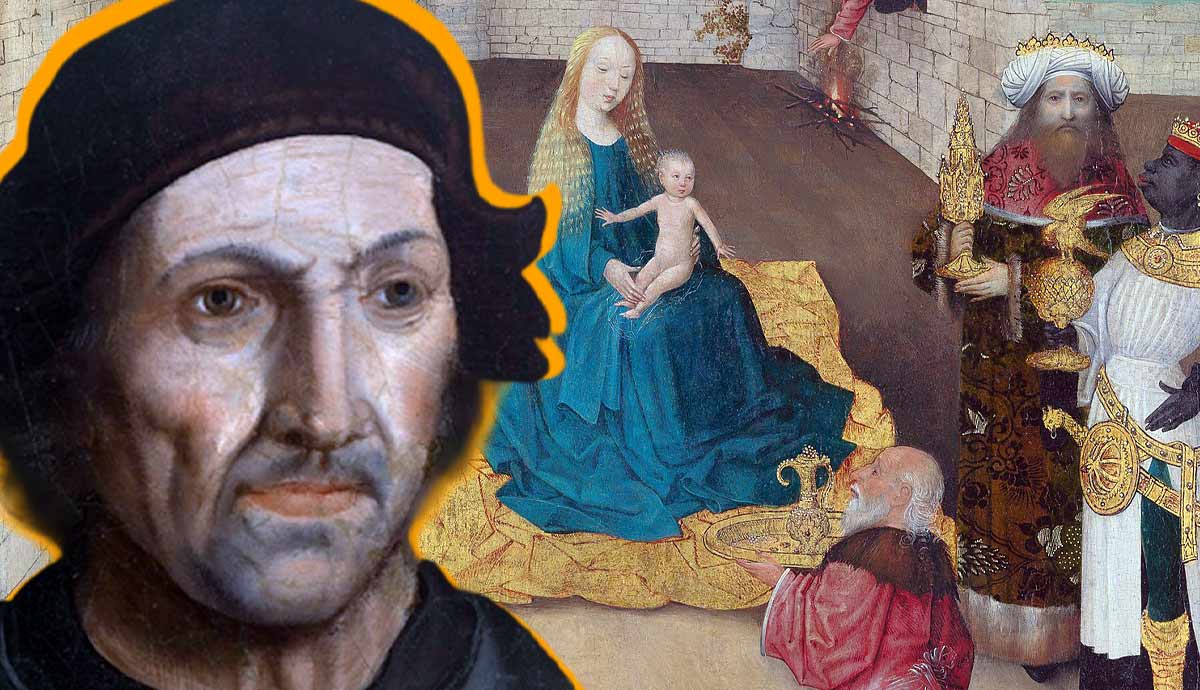
Contemporary British artist Damien Hirst often works with the concepts of death, decay, and impermanence. In 1992, he constructed a life-sized replica of a pharmacy inside an art gallery. This way, he linked the clean and organized space of a medical facility to the white walls of art institutions, which rely on similar principles of categorization and mind manipulation. Later, Hirst turned the project into a restaurant franchise, diluting the message and provoking criticism. Read on to learn more about Damien Hirst’s Pharmacy.
Who Is Damien Hirst?

Damien Hirst was born in 1954 into a working-class family in Bristol, England. His father left the family before Hirst’s teenage years, leaving the son under the influence of a conservative Catholic mother. Hirst was a difficult and troubled teen, uninterested in anything but drawing and shoplifting. His mother opposed his sense of style and hobbies, melting his punk records in a microwave and cutting his Vivienne Westwood trousers, but she encouraged his artistic pursuits.
Before starting his studies at an art college, Hirst worked on construction sites. He started to attract the attention of art collectors during his student years as an emerging conceptual artist working with simple materials like cardboard boxes and house paint. In art school, he worked in a morgue studying anatomy drawings. Hirst experienced a mix of terror and awe, noticing the conflicting and dramatic interaction of life and death. Soon after, he started to create pieces using dead animals, referring to themes like death and decomposition. One of the first major pieces that brought success to Hirst was an installation called A Thousand Years which featured a rotting cow’s head, infested with maggots and flies, encapsulated in a clear glass case.

Over the following years, Hirst resumed his experiments with dead flesh, creating one of the most iconic pieces of contemporary British art. The Physical Impossibility of Death in the Mind of Someone Living, popularly described simply as a “shark in formaldehyde,” once again juxtaposed life and death, preserving the impermanence and inverting the natural order of things.
Today, Hirst is one of the richest and most influential artists in the world. Despite this, he has a questionable reputation within the art world. In his early artistic years, he often told his friends that he couldn’t wait to become famous enough so that he could make bad art and get away with it. In Hirst’s present-day work, many art critics see exactly that and accuse him of using his influence to manipulate the art market.
Pharmacy

Not all important works by Damien Hirst consisted of gory piles of organic matter. In 1992, Hirst presented his installation Pharmacy. It was a white room filled with medicine cabinets, shelves, and packages that felt equally familiar and unsettling to every visitor regardless of their class and experience. There was also a counter where an imaginary non-present employer left their personal belongings. A fly zapper under the ceiling reinforced the inevitable presence of death, making it more tangible and gruesome.
Apart from medicine bottles, boxes, and instruments, Hirst left several references to the medical practices of the past, closely linked to the natural realm instead of chemistry. Four bottles with colored fluids were placed on the counter to refer to the four natural elements. Bowls with honeycomb referred to shamanic practices of healing, perhaps making a subtle homage to the famous Conceptual artist Joseph Beuys, who used honey in his ritualistic performances.
To Hirst, art equals medicine. Thus the white walls of the space mimic the white cube galleries, while colorful pills take the place of artworks. The way doctors categorize and sort their medicine, often following their own logic, is similarly close to the work of curators and art historians, aiming to put all art in labeled boxes of movements and influences to make sense of it.
What Themes Does Pharmacy Explore?

As a total installation, Pharmacy explores the relationship of humans with the space around them and the feelings and fears inspired by a specific setting. The clean sterile space of a pharmacy provokes no discomfort on its own, but its association with illness, pain, and death is unsettling enough even when it is hypothetical. It offers a chance of recovery but no comfort, focusing the visitor on their physicality, fragility, and mortality. The carefully arranged white space, in theory, should be pleasing to the eye with its symmetry and order, but instead, it provokes anxiety.
Pharmacy was not the first experiment Hirst made related to the matter of drugs and medication. In the late 1980s, he arranged compositions from drug packages, placing them according to the position of human organs. This way, Hirst linked and united medicine with the body, equalling one to another.
Some art historians see Hirst’s pharmacy-related objects as reflections of the work by Marcel Duchamp also titled Pharmacy. In Duchamp’s case, the work was a readymade landscape print, on which Duchamp painted two small pill-like dots of color. Another point of inspiration for Hirst came from the works of American artist Joseph Cornell. Raised in the Surrealist tradition, he worked with techniques like assemblage, filling medical cabinets with leaves, shells, and other artifacts of the natural world.
Spot Paintings

Hirst relates to the concept of medicine with a certain share of skepticism, noting its addictive qualities and dangerous side effects. He still acknowledges that for many, these side effects mean much less than the chance to relieve their pain. The choice between addiction and suffering, as well as the appeal of chemical substances is reflected in one of the most famous painting series created by Damien Hirst.
Controlled Substances is a series of structures of colorful dots. Seemingly random, they are coded models of the chemical structures of prescription drugs. The series was an important artifact of the ongoing Opioid crisis and the catastrophe caused by pharmaceutical companies lying to patients about the dangers of addiction. However, Hirst’s desire for profit and self-promotion has ruined the original message of the work, making it almost unrecognizable.
Over the years Hirst simplified the idea, making it easier to reproduce paintings in high demand. Instead of chemical structures reimagined by the artist, the new version consisted of simple randomly colored dots placed by Hirst’s assistants. Hirst has always employed assistants in his studio, requiring help to assemble installations, but the particular case of outsourcing raised concerns about the authenticity of his art. Hirst admitted that he only painted three of his spot paintings and became bored, leaving the rest of the work to his crew.
Damien Hirst: Death, Decay, and Controversial Practices

Our fear of death is normally something we prefer to keep close to our hearts, admitting it, but almost never elaborating on it. Damien Hirst’s strategy is exactly the opposite. He is ready to accept not only the fear of death but our subconscious obsession with it. The pale maidens from the Pre-Raphaelite paintings, the ethereal dying Ophelia, and other fragile artifacts of art history were rooted in this obsession. Hirst’s innovation is in fact a logical development of past tendencies. He refuses to sugarcoat the reality of death and conceal it behind the aesthetically pleasing surface. However, his honesty sometimes crosses too many lines.
Despite the enormous popularity of Damien Hirst’s work, his creative practices received enough criticism and even provoked protests. Many of his works included dissected animals and taxidermy, and some turned into full-blown killing machines. The installation A Thousand Years, Hirst’s breakthrough piece, contained a built-in fly zapper. The viewers had a questionable honor to observe the life cycle of a maggot feeding off a cow’s head, then turning into a fly just to be electrocuted minutes after its transformation. On several occasions, outraged animal rights activists prevented the artwork from being displayed in major museums. According to the research conducted by Artnet, nearly a million animals, including insects, died to propel Hirst’s artistic practice.

Art critics often accuse Hirst of excessive commercialization of his art and promotion of consumerism. Moreover, Hirst was called out for endless self-repetition, with methods and formulas repeated work after work, recycled and reproduced until they lost their appeal. Several years after the initial presentation, Pharmacy turned into a restaurant project, with identical installations creating backdrops for an affordable and rather simple dining experience. Hirst launched his restaurant three times in different locations, all of them closing after a few years with all decorations sold at auctions.










